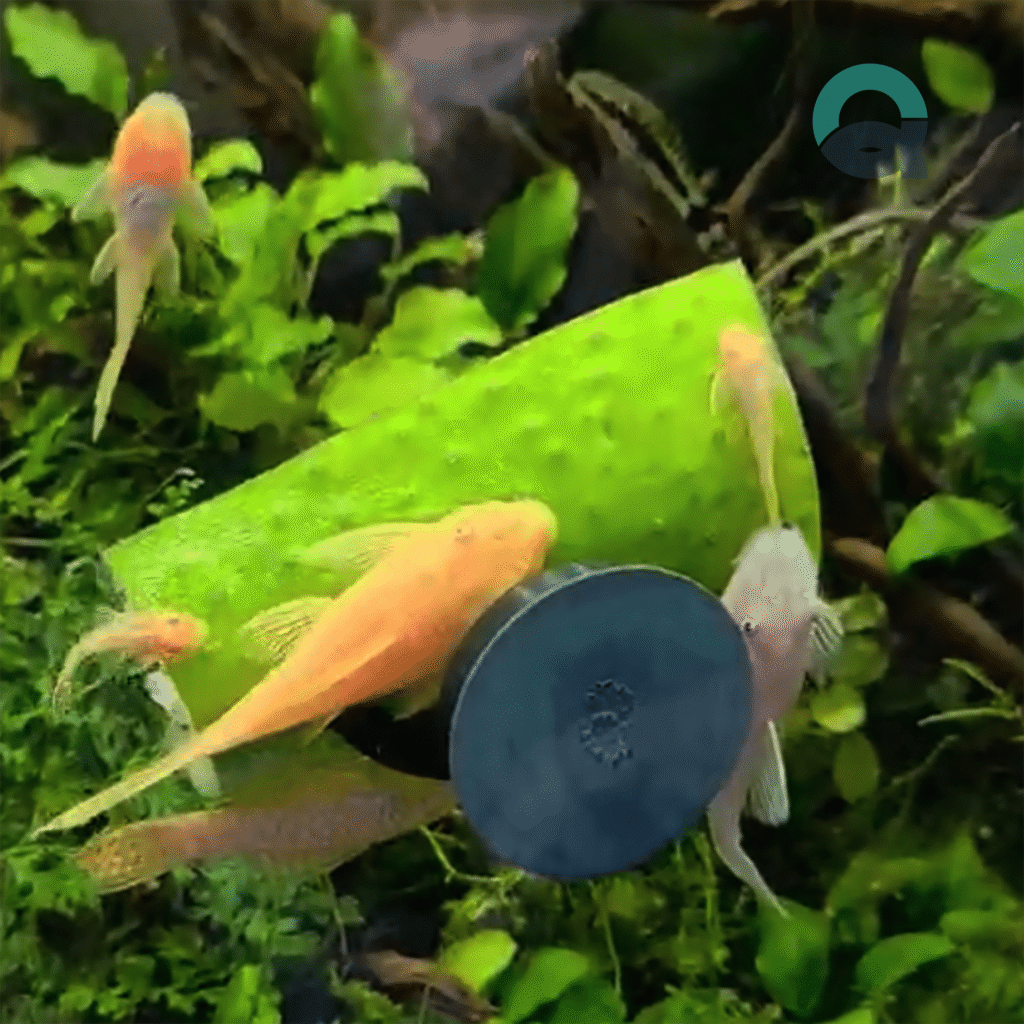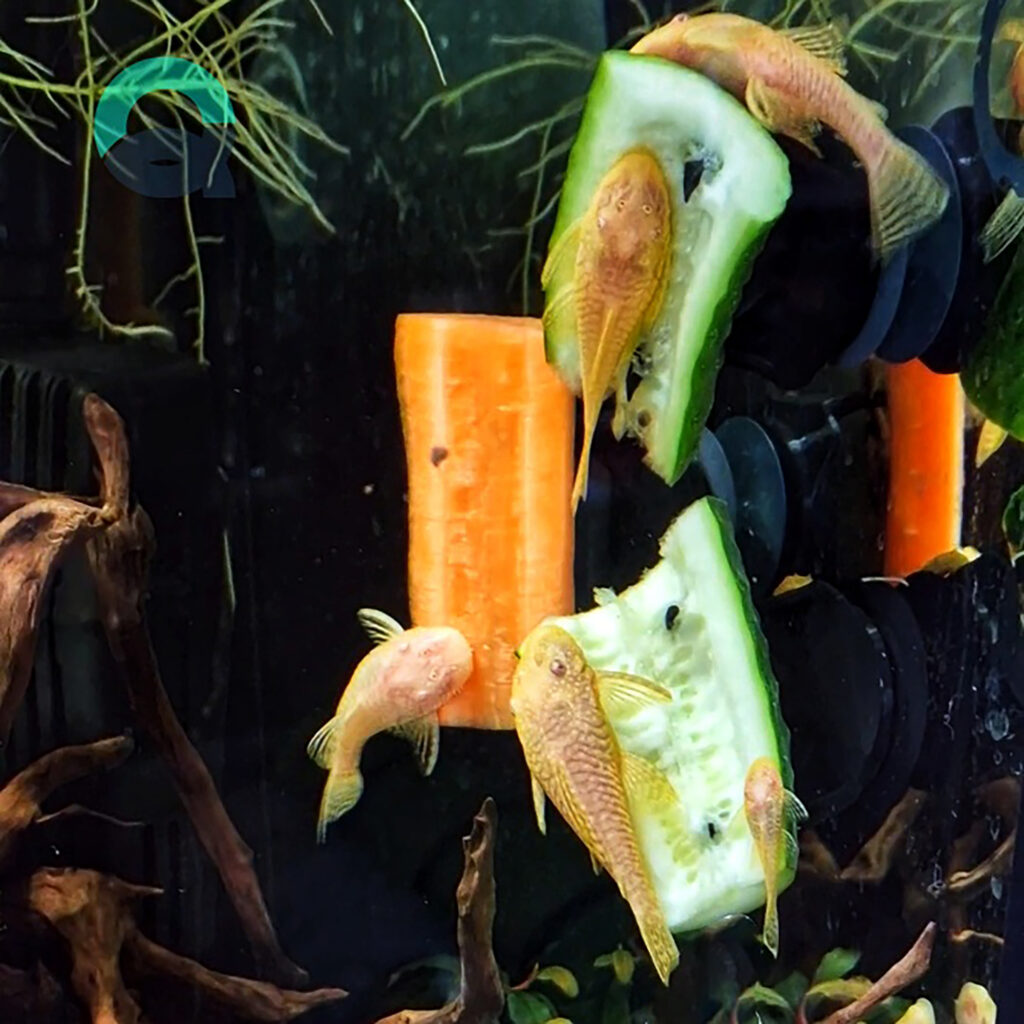Fresh veggies in your aquarium to treat your pets? Awesome idea — until your fish start chasing and hiding it in deepest tank corners 😉 If you’re tired dealing with rotting veggie slices stuck in your fish tank corners — often hidden, hard to reach and nearly impossible to remove without disturbing your substrate, plants or spooking the fish — my 3D printable suction cup veggie holder is about to become your favorite aquarium accessory!
The Benefits of Vegetable Feeding for Bottom Dwellers
Bottom feeders like bristlenose plecos thrive on a fiber-rich diet. Zucchini, cucumber and carrots help them mimic their natural grazing habits, offering:
- 🌱 Fiber for digestion
- 🥕 Vitamins for immunity
- 🧠 Enrichment through grazing behavior
And it’s not just plecos benefiting from the veggie diet:
- Otocinclus get essential algae substitutes
- Shrimp benefit from plant matter for growth and color
- Snails gain calcium for healthy shells
These species love a good snack — but they hate chasing it through the tank. Just throwing some food into the fish tank often results in floating food slices, that drift with the current, making fish swim frantically just to grab a bite — especially frustrating for shy or slow-moving bottom dwellers. With no fixed feeding point, food often ends up behind rocks, stuck in corners,or swirling mid-water, making the tank look messy and stressing out your aquatic pets. Known issues for you? Ok — than continue reading, as I have the perfect, cheap and yet effective 3D printable aquarium accessory, that will close this issue once and for all.

How to Prepare and Slice Veggies for Aquarium Feeding
Some might wonder — why giving fresh, sliced veggies to your aquatic pets is not the best idea? Boiling or blanching vegetables before feeding them to aquarium fish serves several important purposes:
- Preventing Nutrient Loss: Blanching inactivates enzymes that can cause the degradation of nutrients, flavor and color in vegetables. This process helps preserve the nutritional quality of the food offered to fish. (Source: Aquarium Tidings)
- Softening Texture: Many raw vegetables are too hard for fish to consume easily. Boiling softens the vegetables, making them more palatable and easier for fish to nibble on.
- Eliminating Contaminants: Boiling helps remove potential pesticides, bacteria, and other harmful substances present on the surface of vegetables, ensuring the safety of your aquatic pets. (Source: Wiki)
But no one wants to boil the veggies daily. Here’s how to prep them more quickly:
#1: Blanching Method
- Wash the vegetables
Rinse thoroughly to remove dirt or pesticides. - Slice into thin pieces
Thin slices (3–5 mm) soften faster and are easier for fish to eat. - Boil water
Bring a pot of water to a rolling boil. - Blanch the veggies
Place sliced veggies into boiling water:- Zucchini/Cucumber: 30–60 seconds
- Spinach/Leafy greens: 10–20 seconds
- Carrot: 1–2 minutes (softer texture takes longer)
- Cool immediately
Remove from boiling water and drop into cold/ice water to stop cooking. This keeps texture firm but digestible. - Drain and serve
Let them cool to room temperature before feeding your fish.
#2: Quick Soak (my own, even faster, method)
- Place veggie slices in a cup
- Pour with boiling water
- Let soak for 2–3 minutes
- Rinse with cold flowing water letting them cool down
Important: avoid paper-thin slices that fall apart. The suction cup veggie holder needs a good grip to hold the food in place.
So, we already know why the vegetables are essential for bottom-dwelling species like plecos, otocinclus catfish, shrimp and snails. But traditional feeding methods (aka “throw it and hope“) just don’t cut it:
- Food debris clogs the gravel and ruins water quality
- Fish can’t graze naturally, and leftovers often rot
- Cleaning up is a chore—especially in planted tanks
That’s why my 3D printed aquarium feeder solves the core issue: it offers targeted, natural and mess-free feeding.
Why the Aquireef 3D Printed Aquarium Feeder?
Main Advantages of using my Fish Feeding Tool at a Glance:
- 🧼 Cleaner tank — no decomposing food in your gravel or floating pieces in water
- ⏱️ Less maintenance — rinse and reuse
- 🎯 Targeted feeding — less waste, more health
- ♻️ Eco-friendly — no more disposable feeding clips
- 🐟 Happier fish — no stress, no chasing of the food
Now, let’s brake down some key-points and dive in more deeply:
✅ Suction Cup Mount for Clean Feeding
Forget buried in sand or substrate sticks. The suction cup veggie holder:
- Has the design to be 3D printed with two different suction cup attachment holes.
- Attaches to / detaches from aquarium glass in seconds
- No gravel digging, no mess when need to install or remove it
- Keeps veggies suspended mid-tank and always in one place

✅ Smart Fork Design
- Two strong, rounded spikes engineered to hold the food slices firmly without tearing them
- Allows multiple fish feeding at once while you can observe the process


✅ 3D Printable With Aquarium Safe Materials @ Home in Minutes
- Use PETG: underwater long-life and pet-safe material
- Reusable and easy washable
- Costs pennies to print
Best use Practices of the Aquireef 3D Printed Aquarium Feeder
To get the most from your 3D printed aquarium feeder:
- Choose firm veggie slices, not soft mush
- Stick it to a visible glass wall, best practice – always similar place for your pets to know
- Feed every 1–2 days
- Remove uneaten food every 12–18 hours
⚠️ Avoid acidic veggies (e.g. tomato, citrus) — they mess with the water pH and can stress your fish!
Usage Explanation Video
This 17 sec. video showcases the whole process and the result of using my fish feeding tool. Yes, just 17 seconds – as easy, as that!
Final Thoughts: a Small Tool with a Big Impact
Feeding your bottom dwellers should be a joy — not a messy cleanup job after. My designed suction cup veggie holder delivers an elegant, mess-free and efficient solution. A cleaner tank, less maintenance, targeted feeding, eco-friendly and happier pets – that’s what this fish tank 3d print is all about.
Try it once, and your fish, together with your aquarium filter, will thank you!
🗣 Share Your Experience — Do you treat your aquatic pets with veggies? How do you do it? Drop a Comment bellow and be a part of the Community!
Liked this article? Feel free to check out my latest posts:
- Is 3D Printing Food Safe? Here’s the Real Truth
- 3D Printed Reptile Hides Exposed: Crucial for Welfare or Just Terrarium Decor Hype?
- 3D Print Bed Adhesion — What Works Best To Avoid Failed 3D Print?
- Are Aquarium Caves Really Critical for Fish and Shrimp Health? Does 3D Print Decor make a Difference for your Aquatic Pets?
- Why Aquarium Plant Holders Are Changing the Game for Tree Lovers
